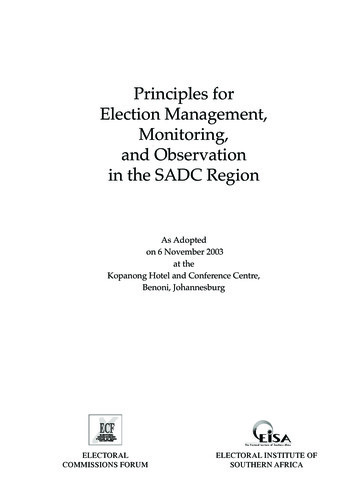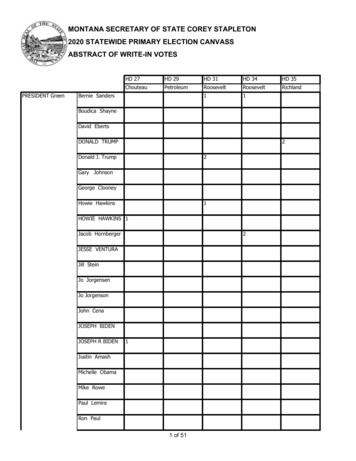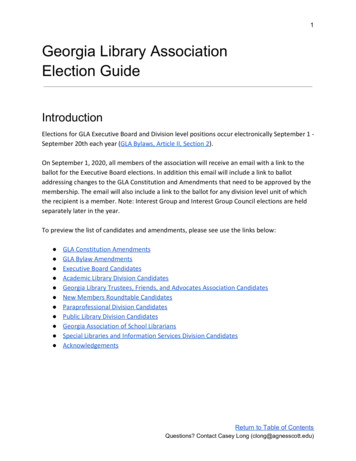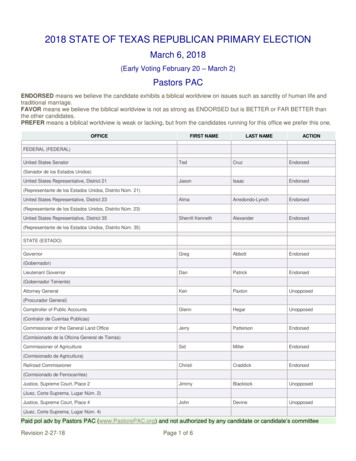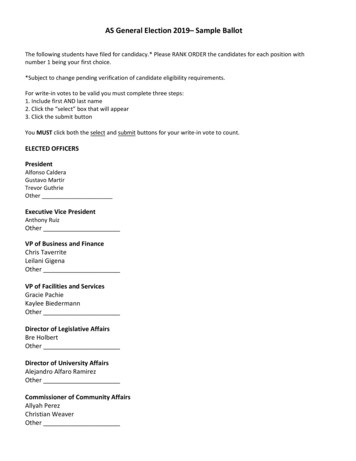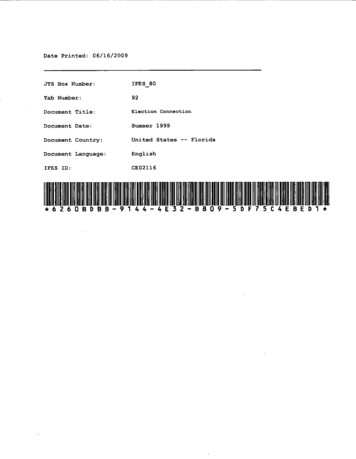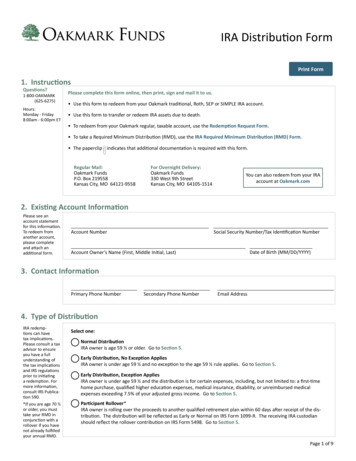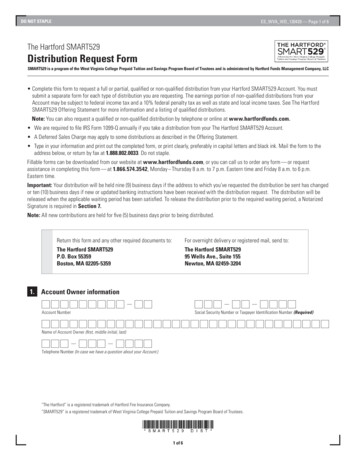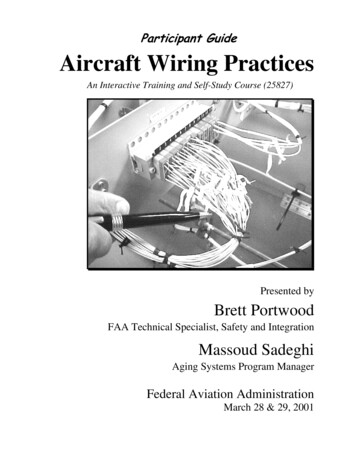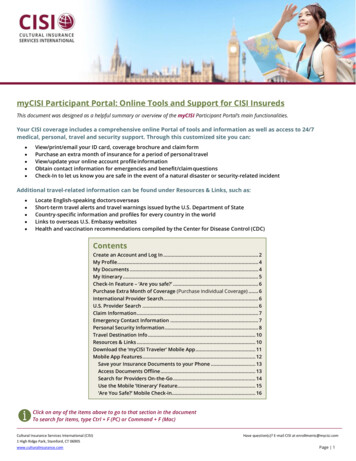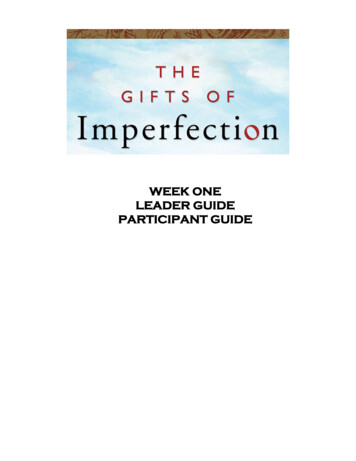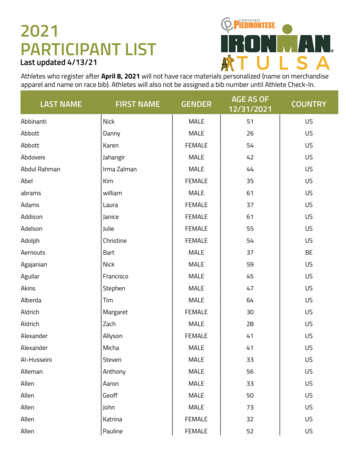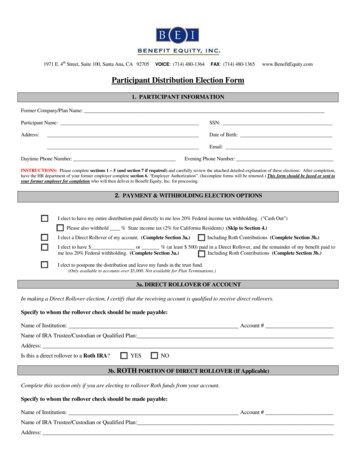
Transcription
1971 E. 4th Street, Suite 100, Santa Ana, CA 92705VOICE: (714) 480-1364FAX: (714) 480-1365www.BenefitEquity.comParticipant Distribution Election Form1. PARTICIPANT INFORMATIONFormer Company/Plan Name:Participant Name:SSN:Address:Date of Birth:Email:Daytime Phone Number:Evening Phone Number:INSTRUCTIONS: Please complete sections 1 – 5 (and section 7 if required) and carefully review the attached detailed explanation of these elections. After completion,have the HR department of your former employer complete section 6, “Employer Authorization”. (Incomplete forms will be returned.) This form should be faxed or sent toyour former employer for completion who will then deliver to Benefit Equity, Inc. for processing.2. PAYMENT & WITHHOLDING ELECTION OPTIONS I elect to have my entire distribution paid directly to me less 20% Federal income tax withholding. ("Cash Out") Please also withhold % State income tax (2% for California Residents) (Skip to Section 4.) I elect a Direct Rollover of my account. (Complete Section 3a.) Including Roth Contributions (Complete Section 3b.) I elect to have or % (at least 500) paid in a Direct Rollover, and the remainder of my benefit paid tome less 20% Federal withholding. (Complete Section 3a.) Including Roth Contributions (Complete Section 3b.) I elect to postpone the distribution and leave my funds in the trust fund.(Only available to accounts over 5,000. Not available for Plan Terminations.)3a. DIRECT ROLLOVER OF ACCOUNTIn making a Direct Rollover election, I certify that the receiving account is qualified to receive direct rollovers.Specify to whom the rollover check should be made payable:Account #Name of Institution:Name of IRA Trustee/Custodian or Qualified Plan:Address:Is this a direct rollover to a Roth IRA? YES NO3b. ROTH PORTION OF DIRECT ROLLOVER (If Applicable)Complete this section only if you are electing to rollover Roth funds from your account.Specify to whom the rollover check should be made payable:Name of Institution:Account #Name of IRA Trustee/Custodian or Qualified Plan:Address:
4. PAYMENT METHODHow would you like the funds to be sent? CheckOR Electronic Fund Transfer* Direct Deposit to my account Checking or SavingsOR Wire - Verify with receiving bank if they accept wires and/or charge a fee.Bank Name:City and State:Routing Number:Account Number:*Please Note: If this option is not available for your account, your payment will be in the form of a check.5. PARTICIPANT AUTHORIZATIONIf you return this form in less than 30 days you will have waived the 30-day waiting period for direct rollover.If neither box is checked, standard processing will prevail. Standard Processing: Please process my distribution within 30 days. I understand “the Plan” may have a distribution fee that will be deductedfrom my account. Rush Processing: Please process my distribution within 10 days. I understand that an ADDITIONAL RUSH FEE of 30 will be deducted frommy account. (This fee includes an overnight mail charge to the participant’s address listed above - NO P.O. BOXES.)Please note: All processing time frames are approximations based upon the receipt of all necessary forms in good order. Incomplete or unsigned forms will delay processing.I understand the terms and conditions relating to the payment of taxable benefits from “the Plan” as explained in the “Special Tax Notice Regarding Plan Payments”. I alsounderstand that any assets that I have in my account will be liquidated once I submit this form and I agree to this liquidation in order to process my distribution. I certify thatthe information I have provided above is true and correct to the best of my knowledge and that the Direct Rollover is an “Eligible Rollover Distribution” as defined in Codesection 401(a)(31)(D). I understand that the trustee of “the Plan” will rely on this information in making the distribution that I have requested. I hereby consent to paymentof my vested account balance.Plan Participant Signature:Date:Print Name:6. EMPLOYER AUTHORIZATIONParticipant’s Date of Termination:Hours worked during the current plan year: Less than 500Date of last payroll contribution: 500-999 1,000 I certify the information given above is true and complete to the best of my knowledge. I understand the participant’s funds will be forwarded per the instructions directed bythe participant unless otherwise specified. In addition, I authorize the withdrawal and disbursement of this benefit according to the terms of this contract and “the Plan”. Pleasedistribute the funds according to the instructions on this “Participant Distribution Form” for the above named participant.EMPLOYERS: Once you have completed this section, make a copy for your records and mail or fax to Benefit Equity, Inc. The fax number is (714) 480-1365. The mailingaddress is 1971 E. 4th St. Suite 100, Santa Ana, CA 92705.Authorized Plan Signature:Print Name:Date:
SPECIAL TAX NOTICEYOUR ROLLOVER OPTIONSYou are receiving this notice because all or a portion of a payment you are receiving from the Plan is eligible to be rolled over toeither an IRA or an employer plan; or if your payment is from a designated Roth account, to a Roth IRA or designated Roth accountin an employer plan. This notice is intended to help you decide whether to do such a rollover.This notice describes the rollover rules that apply to payments from the Plan. To the extent that the rules differ based on whetherthe payment is from a Designated Roth Account or from an account that is Not a Designated Roth Account, those differences will beidentified in each section of this notice.Rules that apply to most payments from a plan are described in the “General Information About Rollovers” section. Special rules thatonly apply in certain circumstances are described in the “Special Rules and Options” section.GENERAL INFORMATION ABOUT ROLLOVERSHow can a rollover affect my taxes?Not a Designated Roth Account:You will be taxed on a payment from the Plan if you do not roll it over. If you are under age 59½ and do not do a rollover, you willalso have to pay a 10% additional income tax on early distributions (unless an exception applies). However, if you do a rollover, youmay not have to pay tax until you receive payments later and the 10% additional income tax will not apply if those payments aremade after you are age 59½ (or if an exception applies). If you do a rollover to a Roth IRA, any amounts not previously included inyour income will be taxed currently (see the section below titled "If you roll over your payment to a Roth IRA (Not a DesignatedRoth Account)").Designated Roth Account:After-tax contributions included in a payment from a designated Roth account are not taxed, but earnings might be taxed. Thetax treatment of earnings included in the payment depends on whether the payment is a qualified distribution. If a payment isonly part of your designated Roth account, the payment will include an allocable portion of the earnings in your designatedRoth account.If the payment from the Plan is not a qualified distribution and you do not do a rollover to a Roth IRA or a designated Rothaccount in an employer plan, you will be taxed on the earnings in the payment. If you are under age 59½, a 10% additionalincome tax on early distributions will also apply to the earnings (unless an exception applies). However, if you do a rollover,you will not have to pay taxes currently on the earnings and you will not have to pay taxes later on payments that are qualifieddistributions.If the payment from the Plan is a qualified distribution, you will not be taxed on any part of the payment even if you do not do arollover. If you do a rollover, you will not be taxed on the amount you roll over and any earnings on the amount you roll over willnot be taxed if paid later in a qualified distribution.A qualified distribution from a designated Roth account in the Plan is a payment made after you are age 59½ (or after yourdeath or disability) and after you have had a designated Roth account in the Plan for at least 5 years. In applying the 5-year rule,you count from January 1 of the year your first contribution was made to the designated Roth account. However, if you did adirect rollover to a designated Roth account in the Plan from a designated Roth account in another employer plan, yourparticipation will count from January 1 of the year your first contribution was made to the designated Roth account in the Planor, if earlier, to the designated Roth account in the other employer plan.Where may I roll over the payment?Not a Designated Roth Account:You may roll over the payment to either an IRA (an individual retirement account or individual retirement annuity) or anemployer plan (a tax-qualified plan, section 403(b) plan, or governmental section 457(b) plan) that will accept the rollover. Therules of the IRA or employer plan that holds the rollover will determine your investment options, fees, and rights to paymentfrom the IRA or employer plan (for example, no spousal consent rules apply to IRAs and IRAs may not provide loans). Further,the amount rolled over will become subject to the tax rules that apply to the IRA or employer plan.If your plan provides for a Designated Roth Account, it may also allow in-plan Roth conversions of amounts not currently heldin the Designated Roth Account. See the section below titled “If your plan allows in-plan Roth conversions” for moreinformation.Designated Roth Account:You may roll over the payment to either a Roth IRA (a Roth individual retirement account or Roth individual retirement annuity)or a Designated Roth Account in an employer plan (a tax-qualified plan, section 403(b) plan, or governmental section 457(b)1
plan) that will accept the rollover. The rules of the Roth IRA or employer plan that holds the rollover will determine yourinvestment options, fees, and rights to payment from the Roth IRA or employer plan (for example, no spousal consent rulesapply to Roth IRAs and Roth IRAs may not provide loans). Further, the amount rolled over will become subject to the tax rulesthat apply to the Roth IRA or the Designated Roth Account in the employer plan. In general, these tax rules are similar to thosedescribed elsewhere in this notice, but differences include: If you do a rollover to a Roth IRA, all of your Roth IRAs will be considered for purposes of determining whether you havesatisfied the 5-year rule (counting from January 1 of the year for which your first contribution was made to any of yourRoth IRAs). If you do a rollover to a Roth IRA, you will not be required to take a distribution from the Roth IRA during your lifetime andyou must keep track of the aggregate amount of the after-tax contributions in all of your Roth IRAs (in order to determineyour taxable income for later Roth IRA payments that are not qualified distributions). Eligible rollover distributions from a Roth IRA can only be rolled over to another Roth IRA.How do I do a rollover?There are two ways to do a rollover. You can do either a direct rollover or a 60-day rollover.If you do a direct rollover, the Plan will make the payment directly to your IRA or an employer plan, or if your payment is from aDesignated Roth Account, to your Roth IRA or Designated Roth Account in an employer plan. You should contact the IRA or RothIRA custodian or the administrator of the employer plan for information on how to do a direct rollover.If you do not do a direct rollover, you may still do a rollover by making a deposit within 60 days according to the rules below:Not a Designated Roth Account:You may make a deposit into an IRA or eligible employer plan that will accept it. You will have 60 days after you receivethe payment to make the deposit. If you do not do a direct rollover, the Plan is required to withhold 20% of the payment forfederal income taxes (up to the amount of cash and property received other than employer stock). This means that, in orderto roll over the entire payment in a 60-day rollover, you must use other funds to make up for the 20% withheld. If you do notroll over the entire amount of the payment, the portion not rolled over will be taxed and will be subject to the 10% additionalincome tax on early distributions if you are under age 59½ (unless an exception applies). If you do a rollover of only aportion of the payment made to you, any nontaxable amounts are treated as being rolled over last.Designated Roth Account:You may make a deposit within 60 days into a Roth IRA, whether the payment is a qualified or nonqualified distribution.In addition, you can do a rollover by making a deposit within 60 days into a designated Roth account in an employer plan ifthe payment is a nonqualified distribution and the rollover does not exceed the amount of the earnings in the payment. Youcannot do a 60-day rollover to an employer plan of any part of a qualified distribution. If you receive a distribution thatis a nonqualified distribution and you do not roll over an amount at least equal to the earnings allocable to the distribution,you will be taxed on the amount of those earnings not rolled over, including the 10% additional income tax on earlydistributions if you are under age 59½ (unless an exception applies). If you do a direct rollover of only a portion of theamount paid from the Plan and a portion is paid to you at the same time, the portion directly rolled over consists first ofearnings.If you do not do a direct rollover and the payment is not a qualified distribution, the Plan is required to withhold 20% of theearnings for federal income taxes (up to the amount of cash and property received other than employer stock). Thismeans that, in order to roll over the entire payment in a 60-day rollover to a Roth IRA, you must use other funds to makeup for the 20% withheld.How much may I roll over?If you wish to do a rollover, you may roll over all or part of the amount eligible forrollover. Any payment from the Plan is eligible for rollover, except: Certain payments spread over a period of at least 10 years or over your life or life expectancy (or the lives or joint lifeexpectancy of you and your beneficiary) Required minimum distributions after age 70½ (or after death) Hardship distributions ESOP dividends Corrective distributions of contributions that exceed tax law limitations Loans treated as deemed distributions (for example, loans in default due to missed payments before your employmentends) Cost of life insurance paid by the Plan Payments of certain automatic enrollment contributions requested to be withdrawn within 90 days of the first contribution Amounts treated as distributed because of a prohibited allocation of S corporation stock under an ESOP (also, there willgenerally be adverse tax consequences if you roll over a distribution of S corporation stock to an IRA).The Plan administrator or the payor can tell you what portion of a payment is eligible for rollover.If I don’t do a rollover, will I have to pay the 10% additional income tax on early distributions?This tax is in addition to the regular income tax on the payment not rolled over.The 10% additional income tax does not apply to the following payments from the Plan:2
Payments made after you separate from service if you will be at least age 55 in the year of the separationPayments that start after you separate from service if paid at least annually in equal or close to equal amounts over your life orlife expectancy (or the lives or joint life expectancy of you and your beneficiary)Payments from a governmental plan made after you separate from service if you are a public safety employee and you areat least age 50 in the year of the separationPayments made due to disabilityPayments after your deathPayments of ESOP dividendsCorrective distributions of contributions that exceed tax law limitationsCost of life insurance paid by the PlanPayments made directly to the government to satisfy a federal tax levyPayments made under a qualified domestic relations order (QDRO)Payments up to the amount of your deductible medical expensesCertain payments made while you are on active duty if you were a member of a reserve component called to duty afterSeptember 11, 2001 for more than 179 daysPayments of certain automatic enrollment contributions requested to be withdrawn within 90 days of the first contribution.Not a Designated Roth Account:If you are under age 59½, you will have to pay the 10% additional income tax on early distributions for any payment from thePlan (including amounts withheld for income tax) that you do not roll over, unless one of the exceptions listed above applies.Designated Roth Account:If a payment is not a qualified distribution and you are under age 59½, you will have to pay the 10% additional income tax onearly distributions with respect to the earnings allocated to the payment that you do not roll over (including amounts withheldfor income tax), unless one of the exceptions listed above applies.If I do a rollover to an IRA, will the 10% additional income tax apply to early distributions from the IRA?If you receive a payment from an IRA when you are under age 59½, you will have to pay the 10% additional income tax on earlydistributions from the IRA, unless an exception applies. In general, the exceptions to the 10% additional income tax for earlydistributions from an IRA are the same as the exceptions listed above for early distributions from a plan. However, there are a fewdifferences for payments from an IRA, including: There is no exception for payments after separation from service that are made after age 55. The exception for qualified domestic relations orders (QDROs) does not apply (although a special rule applies under which, aspart of a divorce or separation agreement, a tax-free transfer may be made directly to an IRA of a spouse or former spouse). The exception for payments made at least annually in equal or close to equal amounts over a specified period applies withoutregard to whether you have had a separation from service. There are additional exceptions for (1) payments for qualified higher education expenses, (2) payments up to 10,000 used ina qualified first-time home purchase, and (3) payments for health insurance premiums after you have received unemploymentcompensation for 12 consecutive weeks (or would have been eligible to receive unemployment compensation but for selfemployed status).If I do a rollover to a Roth IRA, will the 10% additional income tax apply to early distributions from the IRA?If you receive a payment from a Roth IRA when you are under age 59½, you will have to pay the 10% additional income tax on earlydistributions on the earnings paid from the Roth IRA, unless an exception applies or the payment is a qualified distribution. In general,the exceptions to the 10% additional income tax for early distributions from a Roth IRA listed above are the same as the exceptionsfor early distributions from a plan. However, there are a few differences for payments from a Roth IRA, including: There is no special exception for payments after separation from service. The exception for qualified domestic relations orders (QDROs) does not apply (although a special rule applies under which, aspart of a divorce or separation agreement, a tax-free transfer may be made directly to a Roth IRA of a spouse or formerspouse). The exception for payments made at least annually in equal or close to equal amounts over a specified period applies withoutregard to whether you have had a separation from service. There are additional exceptions for (1) payments for qualified higher education expenses, (2) payments up to 10,000 used ina qualified first-time home purchase, and (3) payments after you have received unemployment compensation for 12consecutive weeks (or would have been eligible to receive unemployment compensation but for self-employed status).Will I owe State income taxes
Eligible rollover distributions from a Roth IRA can only be rolled over to another Roth IRA. How do I do a rollover? There are two ways to do a rollover. You can do either a direct rollover or a 60-day rollover. If you do a direct rollover, the Plan will make the payment directly to your IRA or an employer plan, or if your payment is fro m a
